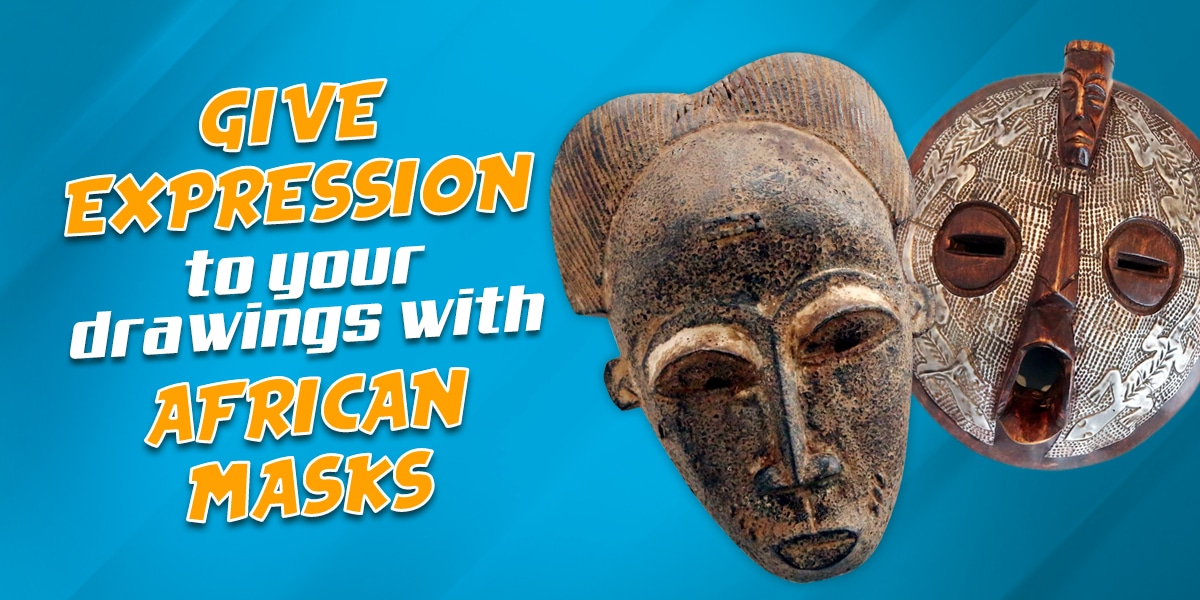Get Inspired by African Masks: A Visual Journey into Expression and Symbolism
African masks are much more than simple decorative objects; they are windows into a world of deep meanings, unique expressions, and an inexhaustible source of inspiration for artists of all eras. In this fascinating journey, we’ll explore how these wooden carved faces have influenced world art and how they can enrich your own creative process.
From cubism to modern animation, African masks have left an indelible mark on the way we conceive and represent the human face. Are you ready to immerse yourself in a universe of shapes, proportions, and symbolisms that challenge the conventional? Join us on this visual journey that promises to transform your perspective on character design and artistic expression.
The Enigma of African Masks: Beyond the Surface
African masks are much more than simple decorative objects. They represent a bridge between the earthly and the spiritual, between the visible and the invisible. Every line, every curve, and every protrusion in these masks tells a story, conveys a message, and evokes emotions that transcend cultural barriers.
We can classify these fascinating creations into four main categories:
- Ancestor spirits
- Mythological heroes
- Combinations of both
- Animal spirits
Far from being objects of everyday use, these masks are reserved for moments of great spiritual and cultural significance. In sub-Saharan cultures, they are primarily used in rituals, ceremonies, and religious events. Their purpose goes beyond aesthetics; they seek to elevate the wearer to a different plane, separating them from the rest of the participants and turning them into a vehicle for higher entities, spirits, and deities.
The symbolic charge of these masks is so profound that exploring their meanings can be an inexhaustible source of inspiration for your own artistic creations. Each mask is a universe in itself, a visual narrative waiting to be deciphered and reinterpreted.


Left: Dan Mask, Tankagle. Ivory Coast. Right: Hemba Mask, Suku Moto. D. R. of Congo. Exhibited at Javier López & Fer France Gallery.
The Artistic Legacy: From Africa to the World
The influence of African masks on Western art is undeniable and profound. Movements such as cubism and expressionism found in these creations a source of renewal and rupture with established artistic conventions.
Cubism, led by figures like Pablo Picasso and Georges Braque, appropriated the geometric simplicity and exaggerated proportions of African masks. These artists revolutionized the representation of the human face, creating portraits that challenged the conventional perception of space and form.
For its part, expressionism embraced the emotional and symbolic charge of these masks. Expressionist artists sought to capture not only the external appearance but also the internal essence and raw emotions, reflected in exaggerated gestures and distorted forms.


Left: “The Scream” by Edvard Munch (1896). Right: “Woman with Hat” by Pablo Picasso (1935).
The influence of African masks didn’t stop at painting. Its impact extended to animation, comics, and illustration, giving life to memorable characters with strong and unsettling personalities. If you’re looking to elevate your skills in creating unique characters, exploring the visual language of African masks can be an excellent starting point.
From Inspiration to Creation: Applying the Essence of African Masks
Incorporating the essence of African masks into your artistic work doesn’t mean copying them directly. It’s more about understanding and applying the principles that make them so powerful and evocative. Here are some ways to do it:
1. Play with Proportions
African masks often challenge conventional anatomical proportions. Experiment by exaggerating certain facial features while minimizing others. This can help you create characters that immediately stand out and convey specific emotions or characteristics visually.
2. Explore Geometric Shapes
Many African masks are based on simple but powerful geometric shapes. Consider how you can incorporate circles, triangles, and squares into your character designs. Each shape has its own symbolic meaning:
- Circles: Represent unity, perfection, and the divine.
- Triangles: Can symbolize stability (pointing upwards) or instability (pointing downwards).
- Squares: Evoke solidity, stability, and order.
3. Focus on Expressiveness
African masks are known for their intense and often exaggerated expressions. Don’t be afraid to take your characters’ expressions to the extreme to communicate emotions more effectively. A deep frown, a smile that occupies the entire face, or disproportionately large eyes can convey much more than more subtle features.
4. Incorporate Symbolism
Every element in an African mask has a meaning. In the same way, you can add layers of meaning to your characters through symbols or decorative elements. These can be subtle nods to the character’s personality or history, or more obvious elements that define their role or powers.

The Joker in “The Killing Joke” by Alan Moore and Brian Bolland, an example of how exaggeration and expressiveness can create an iconic character.
Beyond Imitation: Creating Your Own Visual Language
It’s important to remember that the goal is not to copy African masks, but to be inspired by them to develop your own unique style. Here are some strategies to achieve this:
1. Study and Analyze
Dedicate time to observing different African masks. Analyze their shapes, proportions, and decorative elements. Try to understand why certain features are so effective in conveying emotions or ideas.
2. Experiment with Fusions
Combine elements of African masks with other artistic styles that interest you. For example, you could mix the geometry of masks with elements of art nouveau or futurism.
3. Adapt to Your Medium
If you work in comics or animation, think about how you can translate the static nature of masks into dynamic and expressive characters. Looking for techniques to bring your characters to life? Explore specialized resources in animation and facial expression here.
4. Contextualize
Consider the cultural and historical context of your work. How can you incorporate elements inspired by African masks in a respectful and meaningful way?
Art as a Reflection of Human Culture
It’s essential to recognize that art, in all its forms, is a reflection of human culture. Each step in our evolution as a species has been accompanied by cultural expressions. What we see today as works of art, in many cases, were tools or elements with very different functions from those we assign to art today.
Ancient vessels were objects of daily use, cave paintings were part of hunting rituals, and African masks were (and in many cases still are) tools of spiritual connection. This cultural and historical charge greatly enriches the meaning and value of these creations.
Conclusion: A Call to Creative Exploration
African masks offer us much more than visual inspiration; they invite us on a journey of cultural and artistic discovery. They challenge us to see beyond the conventional, to explore new forms of expression, and to connect with the deep roots of human creativity.
Whether you’re creating characters for comics, designing for animation, or exploring new forms of artistic expression, the lessons we can learn from African masks are invaluable. They encourage you to be bold in your designs, to charge your creations with meaning, and to not fear extreme expressiveness.
Remember, art is an ongoing dialogue between past and present, between cultures, and between artists. By drawing inspiration from African masks, you’re not only paying homage to a rich artistic tradition, but you’re also contributing to the constant evolution of visual art.
The next time you face a blank canvas or an empty page, remember the power and magic of African masks. Let their spirit guide you towards new forms of expression, towards more vibrant characters, and towards art that resonates with the depth of human experience.



